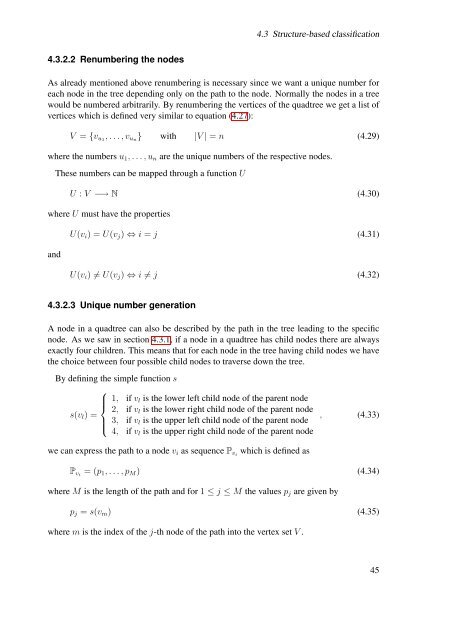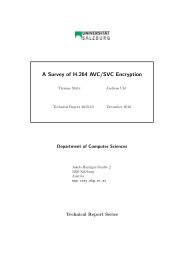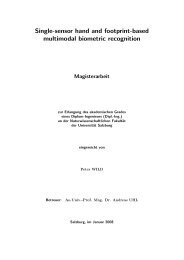Pit Pattern Classification in Colonoscopy using Wavelets - WaveLab
Pit Pattern Classification in Colonoscopy using Wavelets - WaveLab
Pit Pattern Classification in Colonoscopy using Wavelets - WaveLab
You also want an ePaper? Increase the reach of your titles
YUMPU automatically turns print PDFs into web optimized ePapers that Google loves.
4.3 Structure-based classification<br />
4.3.2.2 Renumber<strong>in</strong>g the nodes<br />
As already mentioned above renumber<strong>in</strong>g is necessary s<strong>in</strong>ce we want a unique number for<br />
each node <strong>in</strong> the tree depend<strong>in</strong>g only on the path to the node. Normally the nodes <strong>in</strong> a tree<br />
would be numbered arbitrarily. By renumber<strong>in</strong>g the vertices of the quadtree we get a list of<br />
vertices which is def<strong>in</strong>ed very similar to equation (4.27):<br />
V = {v u1 , . . . , v un } with |V | = n (4.29)<br />
where the numbers u 1 , . . . , u n are the unique numbers of the respective nodes.<br />
These numbers can be mapped through a function U<br />
U : V −→ N (4.30)<br />
where U must have the properties<br />
and<br />
U(v i ) = U(v j ) ⇔ i = j (4.31)<br />
U(v i ) ≠ U(v j ) ⇔ i ≠ j (4.32)<br />
4.3.2.3 Unique number generation<br />
A node <strong>in</strong> a quadtree can also be described by the path <strong>in</strong> the tree lead<strong>in</strong>g to the specific<br />
node. As we saw <strong>in</strong> section 4.3.1, if a node <strong>in</strong> a quadtree has child nodes there are always<br />
exactly four children. This means that for each node <strong>in</strong> the tree hav<strong>in</strong>g child nodes we have<br />
the choice between four possible child nodes to traverse down the tree.<br />
By def<strong>in</strong><strong>in</strong>g the simple function s<br />
⎧<br />
1, if v l is the lower left child node of the parent node<br />
⎪⎨<br />
2, if v<br />
s(v l ) =<br />
l is the lower right child node of the parent node<br />
3, if v l is the upper left child node of the parent node<br />
⎪⎩<br />
4, if v l is the upper right child node of the parent node<br />
, (4.33)<br />
we can express the path to a node v i as sequence P vi which is def<strong>in</strong>ed as<br />
P vi = (p 1 , . . . , p M ) (4.34)<br />
where M is the length of the path and for 1 ≤ j ≤ M the values p j are given by<br />
p j = s(v m ) (4.35)<br />
where m is the <strong>in</strong>dex of the j-th node of the path <strong>in</strong>to the vertex set V .<br />
45








